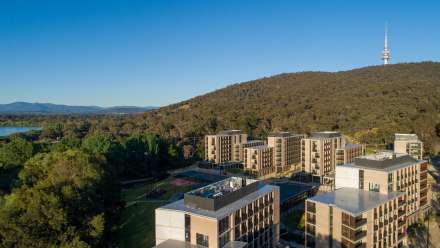ANU Campus Master Plan Frequently Asked Questions
What is the Campus Master Plan?
TheANU Acton Campus Master Plan(the Master Plan) establishes a vision for the campus that will make the most of its extraordinary natural, cultural and built assets. It aims to create a campus that will support the values and ambitions of this unique Australian university and translate them into the lived experience of the campus.
The Master Plan is the principle planning and design resource that will guide investment and renewal across the 143-hectare ANU Acton campus in Canberra over the next 20 years. It provides a flexible framework to guide change over time, enabling projects to be delivered by many hands over many years, responding appropriately to demand, funding availability and resources.
The Master Plan is supported by three important complementary strategies:
- Heritage Framework providing an important underlay of existing campus values to be protected and enhanced in the master plan; a critical layer in the design formulation;
- Energy Strategy providing guidance on new energy infrastructure, and influences the design of buildings and landscape; and
- A Design Guide is also prepared which sets out to inform the campus community and contracted designers a framework on how to resolve the seven principles in a practical and built environment context.
Why does the ANU campus need a new Master Plan?
The University has had previous master plans in place for the Acton campus, however the previous versions were limited in their content and did not fully provide for an integration of design, heritage and energy management – like this plan does.
The University has already achieved global standing for its academic and research achievements, and we want the Acton campus experience to be of equal quality.
A recent comparative review delivered in 2018 by management consultant, Turnberry Consulting, benchmarked the ANU Acton campus against globally high-ranking universities around the world and it was a key resource to informing the development of the Plan. It found that, the campus had some areas for improvement.
Even since the preparation of this report, the University has substantially addressed a number of these issues, e.g. Kambri, but the review emphasised the need for further strategic renewal, with a focus on creating:
- lively campus hubs
- coherent identity and brand
- a positive pedestrian experience
- streamlined traffic and parking
- a stronger connection to Canberra city.
The findings from this report, along with feedback from other key stakeholders, informed and drove the development of the Master Plan.
How much is it going to cost?
The Master Plan is a framework for renewing the campus that will be delivered in stages over 20 years. As such it is not possible to put a total cost on it at this time. It is being done thoughtfully, taking into consideration architectural and design excellence, the natural and landscape setting, places and features that have strong heritage value, a rich indigenous history, environmental sustainability and the best ways to allow movement through campus. Implementation will occur whilst ensuring the University is able to make the most of its investments at each stage.
How can we justify spending the money needed for a renewed campus?
The University’s strategic plan is clear; one of its key goals is the creation of an unrivalled campus experience, a goal which is founded on our commitment to maintaining and enhancing the character of ANU.
Our plan ensures every part of our campus will reflect the high quality of what we do here. To that end, this major regeneration project will deliver renewal throughout our campus – resulting in lively hubs, streamlined traffic and parking, environmental sustainability, optimal use of all spaces, harmonious design and will create a vibrant working and living environment.
How can the University afford this? Will it lead to an increase in student fees?
The Master Plan itself is the vision that will drive and provide a basis for further development on the campus. The various stages will be costed from infrastructure and capital works funds at and when planning for them begins. The University does not envisage or intend that this will impact fees.
Who developed the plan and who did we consult with during its development?
The Master Plan is a product of a collaborative endeavour between the ANU community and the consultant team.
In November 2017, Arup were appointed as the lead consultant for the delivery of the Acton Campus Master Plan. From late 2017 to September 2018, Arup undertook a series of consultation workshops and meetings around the campus with colleges, schools and student associations. In addition, substantial engagement was undertaken with industry partners and external stakeholders such as the ACT Government, National Capital Authority, the City Renewal Authority, the Department of the Environment and Energy, CSIRO and the Australian National Botanic Gardens.
What is being done to address parking?
We acknowledge one of the biggest causes of frustration with the campus is parking. The Council and Executive team are well aware of this situation and therefore have focused on streamlining parking and reducing parking pressures in the Master Plan outcomes.
The Master Plan will create a campus that is pedestrian-oriented, cycle-friendly, easy to get to by public transport, and easy to move around with maximised green space and delivers on our goals of improving our environmental sustainability.
The Master Plan has initially identified 13 potential sites for multi-storey parking – with a view to increasing the overall yield but also removing internal surface parking areas in the centre of the campus and returning these areas back to landscaped areas. The University has recently appointed organisations to review these locations further and provide some design that fits within our campus. Don’t worry – we have factored in more end-of-trip facilities, bike storage and electric bike and car charging spots into the requirements too. We expect to see the first concept designs and updated yield studies by late September 2019. Following approvals, it is anticipated that construction may commence on the first parking site in early 2020 with completion by September 2020.
We are also looking to improve our shuttle bus service that will undertake a ‘loop’ around the inner perimeter of the campus. We want the campus shuttle to be a frequent service that meets the needs of our community. We hope to trial a new service later this year – ensuring it covers the peak periods in the morning and afternoon and later evening, allows for safe travel for those with young children to childcare centres, a bike rack at the front and a bus that allows for those with mobility difficulties.
Will the new parking cost more?
Building better parking facilities may result in higher fees, but it is too early to say and ANU is committed to keeping parking costs as low as possible. The University does not make any profit from parking but nor will it subsidise parking from funds designated for academic use.
How will we maintain the heritage value of the campus?
The Master Plan is the first ANU Master Plan to acknowledge the Indigenous heritage of the ANU site and to take active steps to preserve that heritage.
The University keenly understands the value of its heritage and the importance of managing and respecting this legacy.
The Master Plan includes the new ANU Acton Campus Heritage Framework. The framework confirms the key heritage values of the campus and identifies elements and attributes that must be protected and celebrated. It also guides heritage management and is a key input to campus planning and future development.
Coinciding with the launch of the Master Plan, the University announced that it will undertake a major refurbishment of the School of Art and Design building, one of the key heritage buildings on the campus.
How will the Campus Master Plan benefit our neighbours and the ACT community?
The ANU Strategic Plan recognises the value of the University to Australia, and its status as an institution of national significance. Improvements to the amenity of the campus will reflect not only these values but will make living, studying and working on, and visiting the campus, a more pleasant experience for everyone.
The Master Plan highlights key opportunities to improve the physical connections between ANU, Civic, CSIRO and West Basin on Lake Burley Griffin. It has developed this element in partnership with the ACT Government, National Capital Authority and city neighbours.
What is the University doing to ensure environmental sustainability under the Master Plan?
One of the key principles underlying the design of the Master Plan has been environmental sustainability. The University’s commitment to environmental sustainability will be reflected in all new architecture, public-realm and landscape projects on campus. It will be implemented through a suite of initiatives across all areas of environmental impact, including energy use, habitat, resources and waste.
A new ANU Acton Campus Energy Management Strategy has been developed as a complementary and integrated element of the Campus Master Plan and carbon emissions generated by the University will be reduced over the life of the Master Plan, which reflects an objective from the Strategic Plan.
Why do we need a Design Guide?
The ANU Acton Campus Design Guide (the Design Guide) supports the delivery of the Master Plan. It provides more detailed information for those delivering projects on campus, to support the implementation of the principles and design elements defined in the Master Plan. Its key aim is to ensure there is a coherence to future design and development projects all across the campus into the future.
It will be used extensively by our internal project teams and the organisations who will tender for and undertake our design and construction work. The Design Guide covers the technical elements such as ‘built form, movement, use and landscape’ but also includes a handy checklist at the back of the document to ensure we stay on track.
Was Kambri part of the Master Plan?
The highly-lauded renewal project at the heart of the ANU campus, Kambri, predates the Master Plan but demonstrates many of the key principles of the Master Plan. The Master Plan incorporates development around a number of hubs, and Kambri is one of the key hubs in this network. The lessons learnt from the Kambri regeneration project will also inform the implementation of the Master Plan. Kambri’s distinct aesthetic and design will set the tone for the design of all new buildings and ‘hubs’ developed across the campus as part of the Master Plan.
Where to from here?
The Master Plan proposes an implementation framework. The implementation framework is at the back of the Master Plan document, and it outlines projects that can be realistically undertaken over the next five years (2019-2023) – we are ready to start with many of these now. A second phase of projects is provided for from 2023 and beyond. A further range of opportunity projects are proposed that can be undertaken in conjunction with any agreed projects from 2019 onwards.
Sequencing of projects over the next five years is vital if the Master Plan is to be a reality but needs to be carefully considered against the need for renewal, budget and construction programs across the campus. Projects will likely be undertaken in ‘packages of work’, with a key focus to establish and update some of the internal road networks and develop the promenades to encourage pedestrian and bicycle movements across campus. Concurrently, the issue of campus parking is also being addressed.
Further information?
I have a number of questions about the Master Plan and/or supporting documents. Who can I contact?
The Master Plan and supporting documents is managed by the Facilities and Services Division. In the first instance, please send an email through to Masterplan@anu.edu.au and a member of the team will be in touch as soon as possible.


